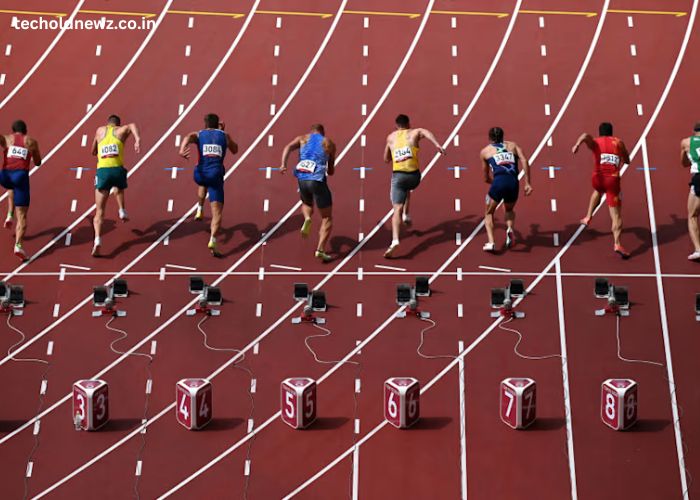Sports tracks are an essential part of athletic events. They provide a controlled and safe environment for runners and athletes to perform at their best. A well-designed sports track not only ensures the athletes’ safety but also enhances their performance. It serves as a foundation for various athletic activities, from running to hurdling, and is a key component of track and field sports.
Key Points:
- Sports tracks play a vital role in track and field events.
- The material used in sports tracks significantly impacts performance.
- Sports tracks must be regularly maintained for safety and durability.
What Are the Different Types of Sports Tracks?
Sports tracks come in various types, each suited for specific activities and conditions. The most common types include:
1. Asphalt Tracks:
Asphalt tracks are made from a mixture of asphalt and rubberized components. These tracks are widely used because of their affordability and durability. They are suitable for a range of weather conditions, making them a popular choice for many high schools and recreational centers.
Advantages:
- Cost-effective
- Long-lasting
- Suitable for a variety of weather conditions
Disadvantages:
- May not be as cushioned as synthetic options
- Can deteriorate faster if not properly maintained
2. Synthetic Tracks:
Synthetic tracks are made from materials like polyurethane or polyvinyl chloride (PVC). They are designed to provide an optimal running surface that is cushioned and shock-absorbent. These tracks are used in competitive sports events like the Olympics because they offer superior performance.
Advantages:
- High-quality surface for maximum performance
- Reduced risk of injury due to shock absorption
- Requires less maintenance
Disadvantages:
- More expensive than asphalt
- Can become slippery when wet
Comparison Table: Asphalt vs. Synthetic Tracks
| Feature | Asphalt Track | Synthetic Track |
|---|---|---|
| Durability | Medium | High |
| Performance | Good for general use | Best for competitive events |
| Cost | Low | High |
| Maintenance | Moderate | Low |
| Shock Absorption | Low | High |
3. Gravel Tracks:
Gravel tracks are less common but still found in some areas, particularly for low-budget facilities or training purposes. They are typically made of compacted gravel and provide a rougher surface for athletes.
Advantages:
- Low cost
- Easy to maintain
Disadvantages:
- Uneven surface
- Increased risk of injury
4. Grass Tracks:
Grass tracks are often used for training or smaller competitions. They are naturally available in outdoor settings and are easier to maintain compared to synthetic options.
Advantages:
- Low cost
- Natural surface
Disadvantages:
- Requires regular mowing and care
- Can become muddy and slippery
How Do Sports Tracks Improve Performance?
Sports tracks are designed to improve the performance of athletes by offering the best possible conditions for running and other track events. The material, layout, and design all play an important role in enhancing an athlete’s speed and reducing the risk of injuries.
- Surface Quality: The quality of the track surface significantly affects performance. A smooth and consistent surface ensures that the athlete can maintain speed without the risk of tripping or slipping. Synthetic tracks, for example, offer superior surface quality compared to gravel or grass tracks.
- Shock Absorption: Sports tracks, especially synthetic ones, are designed with shock absorption in mind. This reduces the impact on athletes’ joints, particularly during long-distance running. This cushioning effect can help prevent injuries like shin splints or knee problems.
- Safety Features: Tracks are designed with safety in mind, including proper drainage to avoid water accumulation, clear lane markings for guidance, and a smooth finish to prevent accidents.
Note: Athletes can achieve their best performance on tracks designed specifically for speed and safety.
Why Is Maintenance Important for Sports Tracks?
Sports track maintenance is crucial for ensuring that the track remains safe and usable for athletes. Over time, wear and tear can affect the surface of the track, leading to cracks, uneven areas, and drainage issues.
Common Maintenance Practices:
- Resurfacing: Over time, sports tracks may need to be resurfaced to maintain a smooth running surface. For synthetic tracks, this may involve replacing or adding new layers.
- Regular Inspections: Regular checks for cracks, drainage problems, and surface degradation can help spot issues early before they become costly repairs.
- Cleaning: Keeping the track free of debris ensures that athletes have a safe and clean environment to compete in.
Reminder: Proper maintenance prolongs the lifespan of sports tracks and ensures the safety of athletes.
Maintenance Comparison Table: Synthetic vs. Asphalt Track Maintenance
| Maintenance Activity | Synthetic Track | Asphalt Track |
|---|---|---|
| Resurfacing | Every 5-10 years | Every 10-15 years |
| Cleaning | Low maintenance, occasional | Moderate maintenance needed |
| Cracks Repair | Rarely, needs professional | Frequent, needs patching |
What Are the Benefits of Sports Tracks for Athletes?
Sports tracks offer numerous benefits to athletes, from better performance to reduced injury risks. Let’s explore some of the most significant benefits:
- Improved Speed: A good track surface allows athletes to run at their fastest speeds without interference. A well-designed track is smooth and allows athletes to build momentum without worrying about uneven ground.
- Injury Prevention: Tracks, especially synthetic ones, are designed to reduce the impact on the legs and joints. This minimizes the risk of stress fractures, sprains, and other common athletic injuries.
- Training Efficiency: For athletes in training, the consistent surface of a sports track allows them to measure their performance accurately. This makes it easier for coaches to assess and improve technique and speed.
Note: The safety and comfort provided by sports tracks are essential for athletes at all levels.
Conclusion
Sports tracks are a vital component of athletic events, whether it’s for professional competitions or casual training. The type of track, maintenance, and the materials used all contribute to the overall experience and performance of athletes. By understanding the different types of tracks, their benefits, and the importance of regular upkeep, we can ensure that athletes have the best possible environment to perform in.
Sports tracks are more than just a part of the landscape; they are a critical element in helping athletes achieve their goals. Whether you’re a competitive sprinter or a recreational runner, the right track can make a significant difference.
FAQ’s
- What is the most common type of sports track material? Synthetic tracks are the most common due to their high performance and durability.
- How often should a sports track be resurfaced? Synthetic tracks should be resurfaced every 5-10 years, while asphalt tracks need resurfacing every 10-15 years.
- Can sports tracks be used for other activities? Yes, sports tracks are versatile and can be used for walking, jogging, and various other recreational activities.
- Why is proper track maintenance important? Proper maintenance ensures safety, longevity, and optimal performance for athletes.
- What is the best track for competitive events? Synthetic tracks are generally the best for competitive events because of their smooth surface and shock absorption features.


